The Veterinary Lasers Market is estimated to be valued at USD 246.3 billion in 2025 and is projected to reach USD 582.2 billion by 2035, registering a compound annual growth rate (CAGR) of 9.0% over the forecast period.
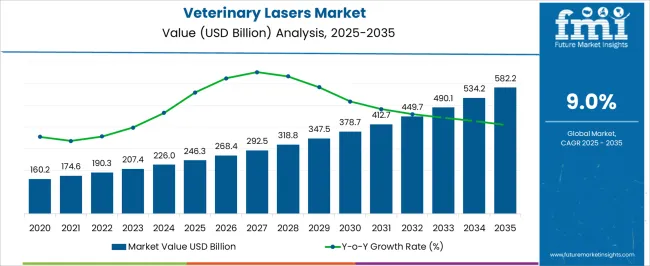
| Metric | Value |
|---|---|
| Veterinary Lasers Market Estimated Value in (2025 E) | USD 246.3 billion |
| Veterinary Lasers Market Forecast Value in (2035 F) | USD 582.2 billion |
| Forecast CAGR (2025 to 2035) | 9.0% |
The veterinary lasers market is experiencing notable expansion due to the growing adoption of advanced treatment modalities in animal healthcare. Increasing awareness of non invasive procedures among pet owners and veterinarians has fueled demand for laser therapies that offer faster healing, reduced pain, and minimal recovery times.
Technological advancements in laser devices, including portability, user friendly designs, and enhanced wavelength precision, have further strengthened their utility in veterinary practices. The market is also supported by rising expenditure on pet healthcare, increasing prevalence of chronic conditions in companion animals, and wider acceptance of integrative veterinary medicine.
Regulatory recognition of therapeutic laser use in animal treatment has additionally contributed to adoption. The outlook remains positive as veterinary practices continue to integrate laser solutions to improve treatment outcomes and enhance animal welfare across companion and livestock categories.
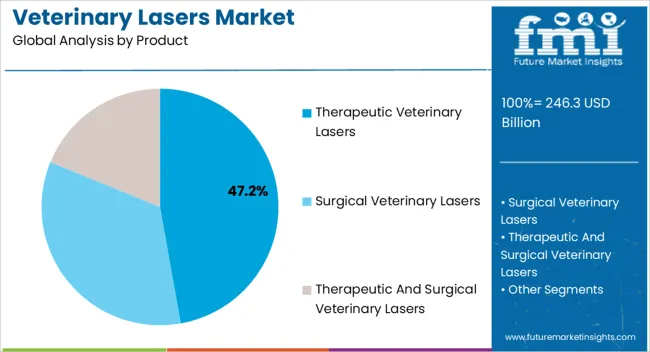
The therapeutic veterinary lasers segment is projected to account for 47.20% of market revenue by 2025 within the product category, establishing itself as the dominant segment. Its growth is driven by widespread use in pain management, wound healing, and rehabilitation treatments.
The ability of therapeutic lasers to provide effective non invasive alternatives for musculoskeletal disorders and post surgical recovery has made them a preferred choice among veterinarians. Rising adoption in both small animal clinics and large veterinary hospitals is further boosting market share.
Continued technological refinements and increasing acceptance of photobiomodulation therapies are reinforcing this segment’s leadership.
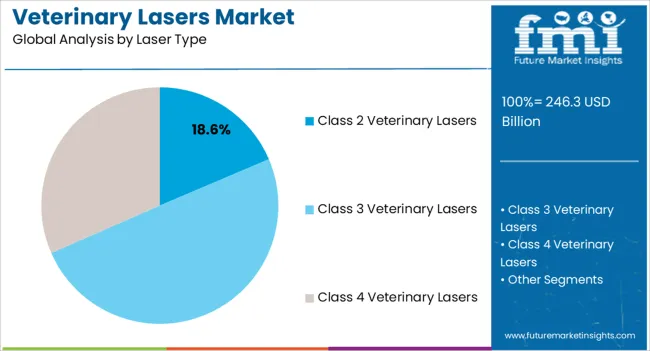
The class 2 veterinary lasers segment is expected to hold 18.60% of total market revenue by 2025, reflecting its significant role in the type category. These lasers are favored for their safety profile, user friendly operation, and suitability for routine therapeutic applications.
Their adoption has been encouraged by regulatory guidelines and practitioner confidence in low power devices that effectively address pain and inflammation without posing risks to animals or operators.
Their cost effectiveness and ease of integration into clinical settings further support strong uptake, making this type a reliable contributor to market growth.
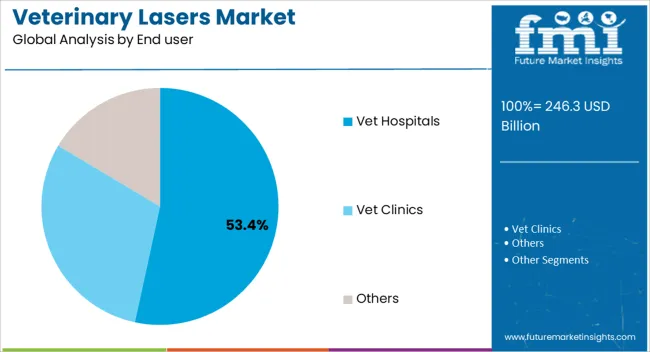
The veterinary hospitals segment is anticipated to generate 53.40% of overall market revenue by 2025, positioning it as the leading end user category. This dominance is linked to the availability of advanced infrastructure, skilled veterinary professionals, and higher patient inflow compared to clinics.
Hospitals are increasingly integrating laser therapy into routine care to improve clinical outcomes, support surgical procedures, and enhance rehabilitation services. Institutional investments in advanced equipment and the ability to provide comprehensive treatment solutions are reinforcing the dominance of this segment.
With growing demand for advanced and holistic veterinary care, hospitals remain the central hub for laser adoption in animal healthcare.
Due to the rising need for therapeutic lasers in line with the development of laser technologies, the global market has grown. With more clinical applications, veterinary practices are adopting therapeutic lasers more and more.
Laser medicine has grown in popularity in conjunction with pharmacological therapy in recent years. Veterinarian lasers are great for lowering musculoskeletal discomfort, post-operative pain, inflammation, and wound healing, among other things. Photobiomodulation therapy has grown significantly in popularity due to the widespread acceptance of these non-invasive treatments in veterinary medicine for treating companion animals as opposed to farm animals.
In 2025, the global market may account for just under 0.4% of the USD 45.4 billion animal health market. Due to its inherent benefits, laser treatment is becoming more and more popular. For instance, new research in veterinary medicine suggests that utilizing laser therapy to treat wounds may speed up the healing process.
Due to an increase in the number of laser-assisted procedures performed in clinical settings, the veterinary lasers market is expected to experience substantial growth between 2025 and 2035.
The market is projected to increase significantly over the following six years at a CAGR of almost 9.4%, with an additional potential of USD 246.3 million from 2025 to 2035. Throughout the projection period, demand for therapeutic lasers may remain at its highest level.
With increased public awareness of emerging technologies, laser surgical technology is widely acknowledged to improve clinical results, provide a more straightforward, convenient process, and have a generally cheap treatment cost. All of these elements are causing the veterinary lasers market to expand.
There has been ongoing development of new items and expansion of their product line to fulfill the rising demand.
For instance, the USA Food and Drug Administration (FDA) approved the Erchonia Corporation's FX 635 low-level laser for marketing in July 2020 to treat all-over musculoskeletal pain.
Numerous significant obstacles to the veterinary lasers industry prevent it from expanding and developing. Along with exclusionary clauses in private health insurance plans, there is a significant lack of insurance coverage for veterinary care in many nations. This lack of funding restricts pet owners' access to veterinary laser treatments, which has an effect on market growth.
The veterinary lasers industry is lacking in highly qualified specialists and professionals. The widespread use and efficient use of veterinary lasers are constrained by the lack of qualified staff, which limits the market's potential for growth.
A big barrier is the insufficient infrastructure for veterinary healthcare in developing countries. These areas frequently lack the essential veterinary laser support infrastructure as well as basic animal health care facilities. This discrepancy hinders market growth and restricts the application of veterinary laser technology in underserved regions.
In general, overcoming these obstacles through legislative changes, educational and training initiatives, and enhanced healthcare infrastructure may be essential for promoting the market expansion and wide acceptance of veterinary lasers.
North America Outlook:
| Attributes | Details |
|---|---|
| North America Market Share - 2025 | 28.2% |
| United States Market Share - 2025 | 19.6% |
The United States the leading country of the North American region with a significant market share in 2025 and projected to continue commanding the high growth during the coming years from 2025 to 2035 in veterinary lasers market. The growing populace of pets mainly drives the market growth and their humanization and increasing pets disorder owing to rise in disease incidence.
Asia Pacific Outlook:
| Attributes | Details |
|---|---|
| Japan Market Share (2025) | 8.4% |
| India Market CAGR (2025 to 2025) | 8.3% |
| China Market CAGR (2025 to 2025) | 8.5% |
Japan holds over 8.4% share in the global market in the year 2025, and projected to expand at a CAGR of 8.5%. The rising number of chronic wound surgeries in the country leads to enhance the demand of veterinary lasers.
In 2025, China is expected to hold considerable share in the Global veterinary lasers industry with more than 9.3% share and is projected to expand at a CAGR of 8.5% from 2025 to 2035. This is predominantly due to the rising number of pet hospitals, for instance, as per the recent estimates, currently, there are 12,000 pet hospitals in China and more than 10% are chains from established brands.
The increasing populace of pet per households along with growing awareness for pet health among pet owners to enhance the veterinary lasers market by 2035.
Europe Outlook:
| Attributes | Details |
|---|---|
| France Market Share (2025) | 23.7% |
| France Market CAGR (2025 to 2025) | 10.4% |
| United Kingdom Market CAGR (2025 to 2025) | 9.7% |
France and United Kingdom to remain the most lucrative countries in veterinary lasers market, expected to grow with a CAGR of 10.4% and 9.7% respectively throughout the forecast period. This is due to high adoption of companion animal’s per-house across these countries. The per-capita veterinary spending is for United Kingdom was around USD 93 in 2020 and while France was around USD 87. This has resulted in a significant shift towards pets visits in healthcare settings for pain management and chronic wound healing.
With significant demand from healthcare settings on usage of veterinary lasers may pave ways for more opportunity during the forecast period.
Product Outlook
| Segment | Therapeutic And Surgical Lasers |
|---|---|
| Segment Share | 43.17% |
By product, the therapeutic and surgical lasers is expected to expand at a CAGR of 9.5% during the forecast period from 2025 to 2035.
With the success of laser therapy among humans, there has been a significant inclination of veterinarians towards usage of therapeutic and surgical lasers for rehabilitation purposes as well as for comfortable procedures. These lasers have a unique ability to vaporize or expunge the tissue and are also utilized to make incisions, as well as to erase unhealthy tissue.
Not only does the laser kill any bacteria during the procedure, but it also seals the lymphatics, hence reports a much less swelling post-operatively. This enables the pet to resume its normal activities sooner.
Owing to the technological benefits of the laser therapy, the veterinary lasers market is experiencing its faster adoption and hence the growth is reflected. Therefore it’s driving the demand for veterinary lasers during the forecast period from 2025 to 2035.
Laser Type Outlook
| Segment | Class 3 Type Laser |
|---|---|
| Segment Share | 45.64% |
The Class 3 type laser dominated the veterinary lasers market in laser type segment, contributing an around 45.64%of the revenue share in 2025. This trend is expected to continue to grow during the study period. The high share of this segment is attributed to its inherited safety and increased usage in pet surgeries and related treatment as compared to other devices.
| Segment | Veterinary Hospitals |
|---|---|
| Segment Share | 40.9% |
Based on the end user, Veterinary hospitals remains the leading segment, with more than 40.9% market share in 2025. Growing number of pet visits for surgical treatments in these hospitals may provide lucrative opportunities for market growth for veterinary lasers.
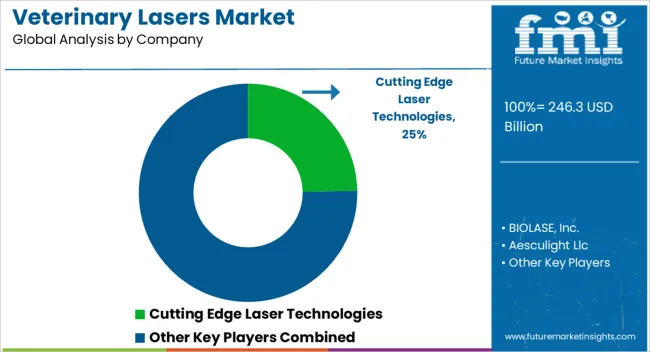
Technological advancements and increasing development of new product lines to provide cost effective devices are the key strategies adopted by manufacturers and integrators for technology transfer and to increase consumer base in different geographies.
Key players are focusing on expansion of their brands and technology in emerging regions by strategic partnerships, and collaborations by key manufacturers to strengthen their market presence.
Key Players
Novel Breakthroughs and Advancements:
| Company | Cutting Edge Laser technologies |
|---|---|
| Strategy | Cutting Edge Laser Technologies Forms Partnership with Patterson Veterinary for Laser Distribution |
| Details | In Oct 2020, Cutting Edge Laser technologies entered into a strategic partnership with Patterson Veterinary. Patterson Veterinary may distribute multiwave locked system (MLS) therapy lasers and surgical lasers nationwide |
| Company | LiteCure |
|---|---|
| Strategy | Laser Therapy Powerhouse: LiteCure Teams Up with FYZICAL to Expand Reach |
| Details | In May 2020, LiteCure owned LightForce Therapy Lasers, expanded therapeutic reach by partnering with physical therapy franchise, FYZICAL, as exclusive laser therapy partner to bring their unique rehabilitative and revenue solutions to physical therapists across the country |
The global veterinary lasers market is estimated to be valued at USD 246.3 billion in 2025.
The market size for the veterinary lasers market is projected to reach USD 582.2 billion by 2035.
The veterinary lasers market is expected to grow at a 9.0% CAGR between 2025 and 2035.
The key product types in veterinary lasers market are therapeutic veterinary lasers, surgical veterinary lasers and therapeutic and surgical veterinary lasers.
In terms of laser type, class 2 veterinary lasers segment to command 18.6% share in the veterinary lasers market in 2025.






Full Research Suite comprises of:
Market outlook & trends analysis
Interviews & case studies
Strategic recommendations
Vendor profiles & capabilities analysis
5-year forecasts
8 regions and 60+ country-level data splits
Market segment data splits
12 months of continuous data updates
DELIVERED AS:
PDF EXCEL ONLINE
Veterinary Imaging Market Forecast and Outlook 2025 to 2035
Veterinary CRISPR-Based Detection Kits Market Size and Share Forecast Outlook 2025 to 2035
Veterinary Pregnancy Test Kit Market Forecast and Outlook 2025 to 2035
Veterinary X-Ray Illuminators Market Size and Share Forecast Outlook 2025 to 2035
Veterinary Scales Market Size and Share Forecast Outlook 2025 to 2035
Veterinary Grooming Aids Market Size and Share Forecast Outlook 2025 to 2035
Veterinary Micro-fibre Endoscope Market Size and Share Forecast Outlook 2025 to 2035
Veterinary Faecal Filters Market Size and Share Forecast Outlook 2025 to 2035
Veterinary Dental Equipment Market Size and Share Forecast Outlook 2025 to 2035
Veterinary Rapid Test Market Size and Share Forecast Outlook 2025 to 2035
Veterinary Therapeutic Diet Market Size and Share Forecast Outlook 2025 to 2035
Veterinary Glucometers Market Size and Share Forecast Outlook 2025 to 2035
Veterinary Pain Management Drugs Market Size and Share Forecast Outlook 2025 to 2035
Veterinary Anesthesia Machines Market Size and Share Forecast Outlook 2025 to 2035
Veterinary Thermography Market Size and Share Forecast Outlook 2025 to 2035
Veterinary Respiratory Disease Treatment Market Size and Share Forecast Outlook 2025 to 2035
Veterinary Orthopedic Drills Market Size and Share Forecast Outlook 2025 to 2035
Veterinary Hospital Market Size and Share Forecast Outlook 2025 to 2035
Veterinary Regenerative Medicine Market Size and Share Forecast Outlook 2025 to 2035
Veterinary Eye Care Market Size and Share Forecast Outlook 2025 to 2035

Thank you!
You will receive an email from our Business Development Manager. Please be sure to check your SPAM/JUNK folder too.
Chat With
MaRIA